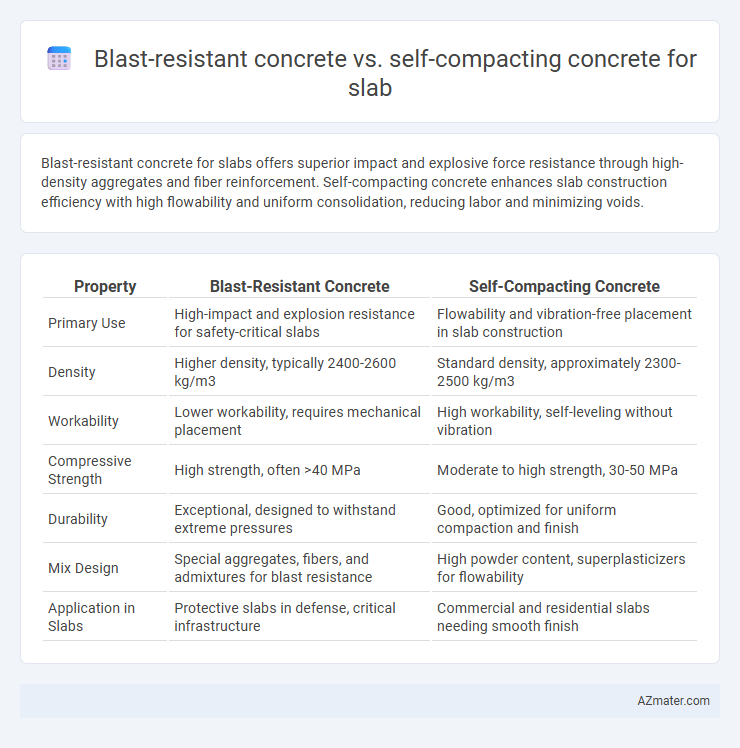Blast-resistant concrete for slabs offers superior impact and explosive force resistance through high-density aggregates and fiber reinforcement. Self-compacting concrete enhances slab construction efficiency with high flowability and uniform consolidation, reducing labor and minimizing voids.
Table of Comparison
| Property | Blast-Resistant Concrete | Self-Compacting Concrete |
|---|---|---|
| Primary Use | High-impact and explosion resistance for safety-critical slabs | Flowability and vibration-free placement in slab construction |
| Density | Higher density, typically 2400-2600 kg/m3 | Standard density, approximately 2300-2500 kg/m3 |
| Workability | Lower workability, requires mechanical placement | High workability, self-leveling without vibration |
| Compressive Strength | High strength, often >40 MPa | Moderate to high strength, 30-50 MPa |
| Durability | Exceptional, designed to withstand extreme pressures | Good, optimized for uniform compaction and finish |
| Mix Design | Special aggregates, fibers, and admixtures for blast resistance | High powder content, superplasticizers for flowability |
| Application in Slabs | Protective slabs in defense, critical infrastructure | Commercial and residential slabs needing smooth finish |
Introduction to Advanced Concrete Technologies
Blast-resistant concrete incorporates high-strength aggregates and specialized fibers to enhance durability and impact resistance, essential for protective slabs in high-risk environments. Self-compacting concrete (SCC) features a highly flowable mix with superplasticizers and viscosity modifiers, allowing it to fill complex forms and dense reinforcement without mechanical vibration. Advanced concrete technologies merge these innovations to develop slabs that optimize structural integrity, safety, and constructability in demanding infrastructure projects.
Overview of Blast-Resistant Concrete
Blast-resistant concrete is engineered to withstand extreme pressure and explosive forces, making it ideal for slabs in high-risk environments such as military facilities and critical infrastructure. Its composition includes high-strength aggregates, fiber reinforcements, and specialized admixtures to enhance toughness and energy absorption under blast loads. Designed to minimize fragmentation and structural failure, blast-resistant concrete ensures enhanced safety and durability compared to conventional or self-compacting concrete slabs.
Key Features of Self-Compacting Concrete
Self-compacting concrete (SCC) offers superior flowability and deformation capacity without the need for mechanical vibration, ensuring uniform distribution and minimizing voids in slab construction. SCC's high-quality finish reduces surface imperfections and enhances durability, making it ideal for complex forms and congested reinforcement areas. Unlike blast-resistant concrete, SCC prioritizes ease of placement and homogeneity, critical for achieving smooth, defect-free slabs in large-scale projects.
Performance Comparison Under Extreme Loads
Blast-resistant concrete exhibits superior performance under extreme shock loads due to its enhanced tensile strength and energy absorption capacity, which significantly reduces spalling and structural damage during explosions. Self-compacting concrete, while excelling in flowability and ease of placement for complex slab geometries, typically lacks the specialized reinforcements and fiber content necessary to withstand high-intensity blast pressures. The choice between these concretes for slab construction hinges on balancing durability under dynamic loads with construction efficiency and surface finish requirements.
Strength and Durability Analysis
Blast-resistant concrete exhibits superior strength and impact resistance, utilizing high-performance aggregates and fiber reinforcements to withstand explosive forces, making it highly durable in extreme conditions. Self-compacting concrete, while offering excellent workability and uniformity without mechanical vibration, provides moderate strength levels with enhanced durability primarily through improved compaction and reduced voids. For slab applications requiring maximum blast resistance and structural integrity, blast-resistant concrete demonstrates better long-term durability under high-stress scenarios compared to the generally resilient but less impact-focused self-compacting concrete.
Construction Efficiency and Workability
Blast-resistant concrete offers enhanced durability and safety for slabs exposed to high-impact forces, featuring dense aggregate compositions that reduce porosity and improve structural integrity. Self-compacting concrete prioritizes superior workability, enabling rapid placement without vibration, thus significantly increasing construction efficiency by reducing labor and time. For slab applications where speed and ease of installation are critical, self-compacting concrete provides optimal workability, whereas blast-resistant concrete is preferred when structural resilience under extreme conditions is paramount.
Cost Implications and Economic Considerations
Blast-resistant concrete demands higher material costs due to specialized admixtures and reinforcement, increasing initial slab expenses compared to standard mixes. Self-compacting concrete reduces labor costs and accelerates construction timelines by eliminating mechanical vibration, offering economic benefits for slab projects. Evaluating long-term durability and maintenance expenses is crucial, as blast-resistant slabs may lower risk-related financial impacts despite their upfront premium.
Applications in Slab Construction
Blast-resistant concrete is engineered for high-impact environments, providing enhanced durability and safety in critical slab applications such as military facilities, industrial plants, and security installations. Self-compacting concrete offers superior flowability and segregation resistance, making it ideal for complex slab geometries and congested reinforcement areas in commercial and residential buildings. Both materials improve slab performance but are selected based on specific structural and environmental requirements to optimize safety and constructability.
Sustainability and Environmental Impact
Blast-resistant concrete incorporates dense aggregates and high-strength fibers, enhancing durability and reducing the need for frequent repairs, thereby lowering long-term environmental impacts. Self-compacting concrete, designed for superior flowability without vibration, minimizes energy consumption during placement and optimizes material usage, contributing to sustainable construction practices. Both materials promote sustainability by extending slab lifespan and reducing carbon footprints, but self-compacting concrete often offers greater efficiency in resource utilization and labor savings.
Conclusion: Choosing the Optimal Concrete for Slabs
Blast-resistant concrete offers superior protection against explosive impacts due to its enhanced toughness and energy absorption capabilities, making it ideal for high-security structures and critical infrastructure. Self-compacting concrete, known for its high flowability and ease of placement without vibration, ensures uniform slab quality and reduces labor costs in complex formwork situations. Selecting the optimal concrete depends on structural demands: prioritize blast resistance for safety-critical applications, while self-compacting concrete suits projects emphasizing construction efficiency and surface finish quality.

Infographic: Blast-resistant concrete vs Self-compacting concrete for Slab
 azmater.com
azmater.com